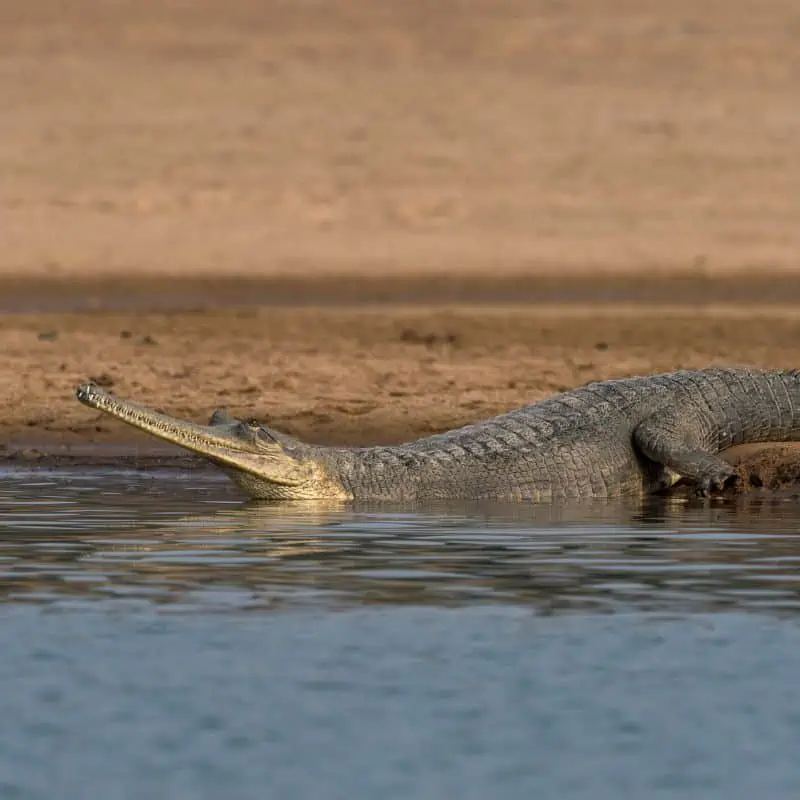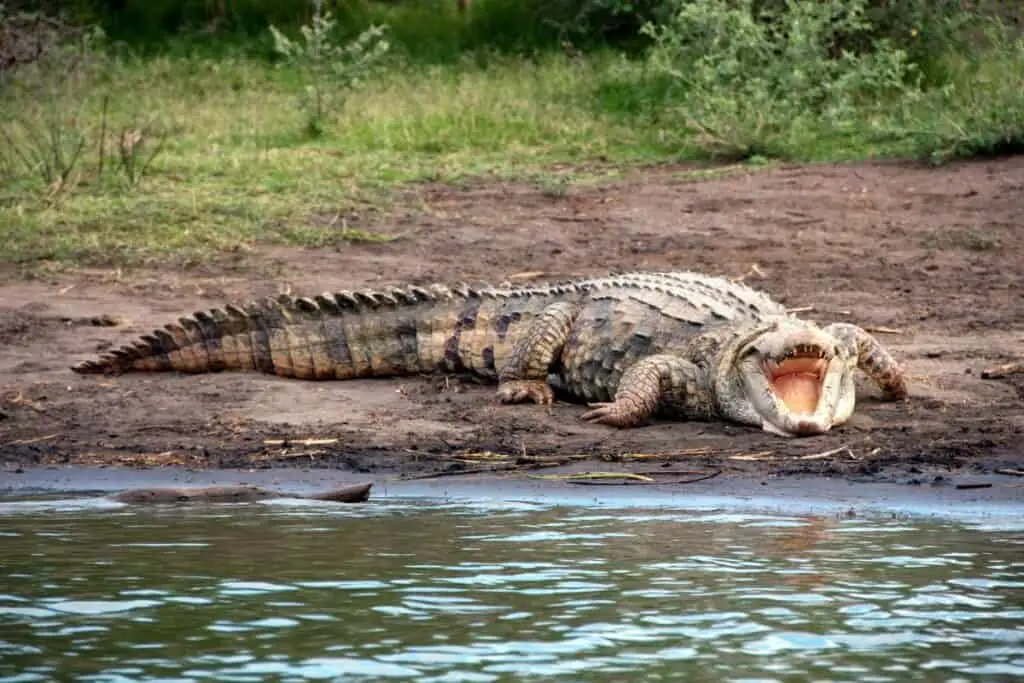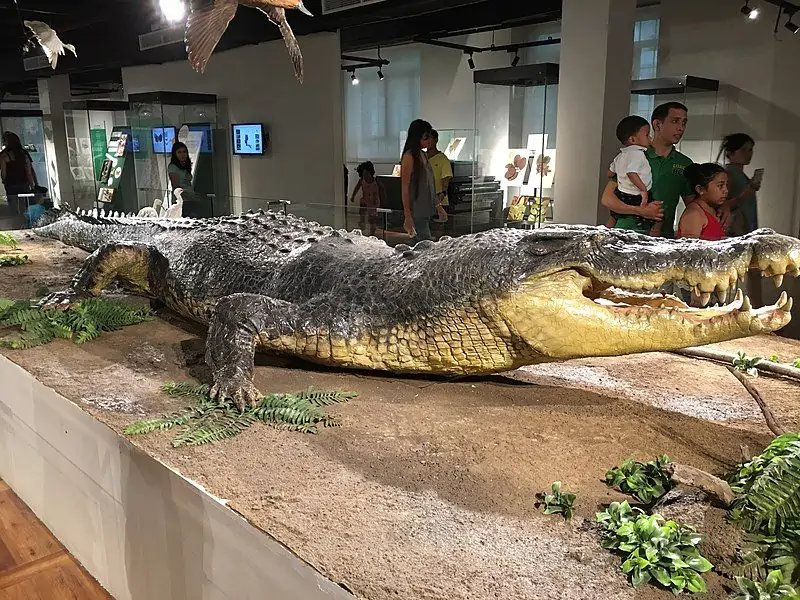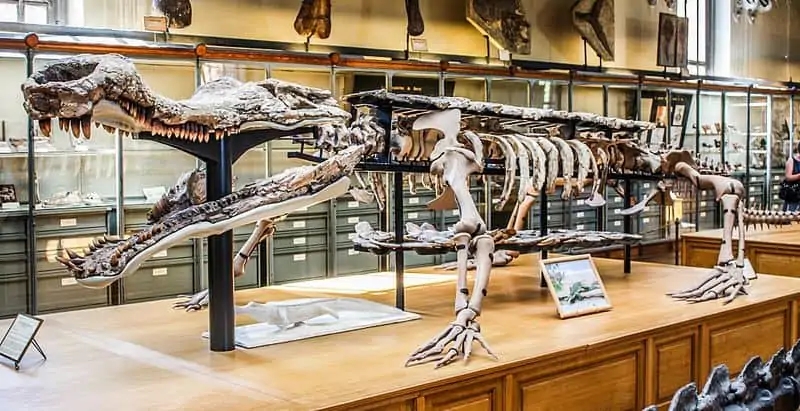Crocodilians, a group of reptiles including crocodiles and alligators, have been around since the dinosaurs (literally). They have immensely powerful jaws, are cunning and efficient hunters, and can live over 100 years – but what was the largest crocodile ever?
The largest crocodile ever captured was Lolong, who died in 2013. This monster was a 20 ft, three inches long saltwater crocodile and weighed 2,400 pounds. The largest crocodilian ever was the fearsome Sarchosuchus imperator at 41 feet long and 17,600 pounds, which lived about 112 million years ago.
To get an accurate idea of the largest crocodile ever, we need to look at the modern crocs and see which are the largest ones currently alive in captivity or the wild, as well as consider the largest prehistoric crocodiles who dwarf their modern cousins by some margin.

- The Largest Crocodile Species Today
- Top 10 Largest Crocodilian Species Today
- What Was The Largest Crocodile Ever Captured
- The Nine Largest Crocodiles Ever Recorded
- The Unofficial Largest Crocodiles Ever
- The Largest Crocodiles Ever Lived Millions Of Years Ago
- Final Thoughts On The Largest Crocodiles Ever
The Largest Crocodile Species Today
There are a few different species of crocodiles, and the largest of those is the saltwater crocodiles or ‘salties,’ which average around 16-17 ft for males. They dominate as consistently the largest crocs on the planet and own the top two spots of the largest living crocodiles.
Sadly, these magnificent creatures were hunted mercilessly, so modern giants of longer than average size are rare.
In 2017, in Queensland in Northern Australia, a passerby noticed a massive saltwater crocodile in a river around 17 ft in length. Even though hunting and killing crocodiles is illegal in Australia, this one had been killed with a large-caliber rifle.
It was estimated that this croc was only about 55 years old and was still growing. Should it have lived, it would probably have been one of the largest crocodiles today.
Top 10 Largest Crocodilian Species Today
Before we look at the largest crocodiles that are currently alive and some of those prehistoric monsters, let’s look at the largest species of crocodilians still alive today.
Remember that Crocodilians include not just crocodiles but also alligators, gharials, and caimans.
Here are the top 10 largest crocodilians according to their size:
10. The Slender Snouted Crocodile.
These are native to sub-Saharan Africa and grow to a length of about 10.8 ft.
Their average weight is between 275 lb and 500 lb, with the heaviest one weighing in at 720 lb.
9. False Gharial
This freshwater croc is found in Malaysia, Borneo, Java, and Sumatra.
They grow to around 13 ft long and can weigh more than 460 lb.
8. Mugger Crocodile
Another freshwater crocodile, this one inhabits the Indian subcontinent and Southern Iran. It grows to around 11 ft and can weigh up to 700 lb.
7. Gharial Or Gavial

As one of the largest freshwater crocodilians, the males can grow to between 11 ft and 15 ft in length and weigh on average 350 lb to 990 lb, with some of the heaviest measured at 2200 lb – that’s a ton of bad news.
6. American Crocodile
Found mostly in Southern Florida, the Mexican Coast, and as far south as Peru and Venezuela, these crocs can grow to 14 ft and weigh in at 2200 lb, but these are exceptionally large as the average weight is between 460 and 1000 lb.
5. Black Caiman
These are the largest alligator species on Earth and are found in the Amazon rainforests and freshwater habitats of South America.
Averaging around 550 to 1000 lb, large individuals have been measured at 2400 lb, and they can grow to between 9 ft and 14 ft.
4. Orinoco Crocodile
Found in the Orinoco River Basin in Venezuela and Colombia, this is a critically endangered species hunted almost to extinction for its skin.
They can weigh between 800 lb and 1100 lb, with the largest weighing in at 2400 lb with an average length of between 12 ft and 15 ft.
3. American Alligator
A native of the South Eastern United States, these gators (as they are colloquially known) are the second largest of the alligator species behind the Black Caiman.
Adult males can grow to almost 16 ft, and unverified reports of gators weighing 2400 lb have been circulated. Their average weight is between 500 and 1000 lb.
2. Nile Crocodile

This is a large freshwater crocodile that is mainly found in freshwater habitats in Sub-Saharan Africa and is distributed in the south, eastern and central regions of Africa.
These are the second largest crocodiles and can weigh as much as 2400 lb with an average weight between 550 and 1650 lb. They grow to between 12 ft and 16 ft.
1. Saltwater Crocodile
As the largest crocodile species on the planet, these monstrous reptiles can grow up to 23 ft, although the largest ones ever captured are only around 20 ft.
With an average weight of between 880 lb and 2200 lb, some of the biggest ones weighed 4400 lb or two tons.
What Was The Largest Crocodile Ever Captured
Several very large crocs have been captured, and while the largest one died about ten years ago, there are still some massive crocs living in captivity.

Lolong was a crocodile captured in 2011 by professional hunters in a freshwater pond in the Philippines after being blamed for the deaths of several Water Buffalo and two people.
At the time, Lolong was the largest crocodile ever taken into captivity. He was 20 ft 3 inches long and weighed 2400 lb.
He was relocated to Bunawan Ecopark, where he was placed in a freshwater enclosure so spectators could come and see and admire his immense size.
Sadly, most wild crocs caught and imprisoned don’t do well, and Lolong died just two years after being caught.
He is still the largest croc ever captured.
The Nine Largest Crocodiles Ever Recorded
While Lolong was the largest croc ever captured, quite a few large crocs have made the reptilian headlines.
Let’s take a look at them:
Dominator: 20 ft
“Dominator” is a wild croc living in Australia (where else?) and shares his territory with another monster named Brutus.
Although he has not been officially measured, scientists estimate he weighs more than a ton and is at least 20 ft long.
Bujang Senang: 19 ft 3 Inches
This 19 ft 3-inch saltwater croc was killed in May of 1992 in Borneo and had been accused of killing people in that area for thirty years.
The initial estimate of his size was 25 ft, but after his death, he was measured at 19’ 3” and weighed more than a ton at 2200 lb.
Brutus: 18 ft 4 Inches
The other member of the Adelaide River, along with Dominator, this massive croc has only three legs and weighs over a ton.
Some think Dominator may have had something to do with the lost leg, but the general theory is that he lost it in an encounter with a bull shark – which must have been pretty big.
As you can see from the video below, Brutus and Bull Sharks have a bit of history.
Yai: 18 ft
Yai is an estuarine-Siamese hybrid living at Samut Prakan Crocodile Farm and Zoo in Thailand.
Despite his size, he is remarkably friendly and tolerant with people but still commands respect from his handlers.
Cassius: 17 ft 11 Inches
Cassius is the largest living croc in captivity today, recognized by the Guinness Book Of World Records in 2011, and is around 100 years old.
Cassius, named after former boxing legend Cassius Clay aka Mohammed Ali, was captured in 1987 in northern Australia.
Cassius resides at Marineland Melanesia, on an island along the Great Barrier Reef.
To get an accurate idea of how large this croc is, he is longer than two ping-pong tables placed end to end.
Gomek: 17 ft 8 Inches
Gomek weighed 1896 lb and was between 60 and 80 years old when he died in 1997.
While not as large as Cassius, he ranks in the top ten of the largest crocodiles ever measured.
Puento Noire Crocodile: 17 ft 8.5 Inches
This was a Nile Crocodile and was killed in the Congo during a safety operation.
There is not much more information available on this specimen other than the length at the time of his death.
Jaws III: 17 ft
Jaws III is a huge saltwater crocodile living at the Madras Crocodile Bank Trust and Centre for Herpetology, about 29 miles south of the Indian city of Chennai.
Weighing over a ton, he is believed to be the largest croc in captivity in Asia and draws huge crowds daily.
Matara Crocodile: 17 ft
After being found struggling in a canal in Matara, Sri Lanka, in 2016, this 17 ft 1-ton croc was released back into the wild with the help of the locals and wildlife officials.
Tawi-Tawi Crocodile: 16 ft 11 Inches
In September 2017, a fisherman spotted this massive croc in the island province of Tawi-Tawi in the Philippines. During the capture, the croc became highly aggressive and damaged several boats used to capture him.
Because it is a serious offense to kill a crocodile in the Philippines and carries a fine of up to $2000 or six years in jail, the croc was not harmed and placed under the care of the municipal government.
The crocodiles above are all confirmed and documented animals that were either captured, killed, or live in the wild, but there have been other claims of larger crocs over the years.
Let’s look at some of those before we get into the real monsters.
The Unofficial Largest Crocodiles Ever
While Lolong was the largest crocodile ever documented, another contender estimated to be an inch longer was the Puerto Rico crocodile, which, based on calculations done by scientists after it was discovered and analyzed, calculated length to be 20 ft 4 inches.
This croc drowned in fishing nets in Papua New Guinea in 1983, and while the head and skin had already been removed before records were taken, the estimated total length was calculated at 20 ft 4 inches.
A skull of a saltwater crocodile kept at the Paris Museum originated in Cambodia and is, by applied calculation, estimated at 22 ft 5 inches long.
Other claims that have never been documented properly include a croc called Kalia that lived in Bhitarkanika Park in Orissa State in India and was more than 7 m or 23 ft long.
While Guinness accepted this claim, the difficulty in catching such a large animal and the lack of a photo meant this claim was not recognized or upheld.
One of the largest crocodiles ever was named Krys, after the person that shot it. This took place in 1958, and it was claimed that Krys was 28 ft 4 inches. This claim was never verified, and most ignored the claim because it fell so far out of the normal ranges for saltwater crocs.
Over the years, some truly immense crocodiles have been found and documented.
Maybe out there is one we haven’t seen yet, that has somehow managed to evade being caught and is even larger than any of the crocs we have today, but even these modern monsters pale in comparison to those that roamed the Earth millions of years ago.
The Largest Crocodiles Ever Lived Millions Of Years Ago
If we are looking to establish which was the largest crocodile ever, we need to go back to an age when gigantic reptiles roamed the Earth.
These crocs were truly massive; let’s start with the granddaddy of them all:
1. Sarcosuchus Imperator: 41 ft; 17600 lb

The Sarcosuchus Imperator was the largest crocodile ever. This giant roamed the Earth about 112 million years ago and makes the modern crocs of today look like tadpoles by comparison.
This croc was a fish eater, and most of the fossils found come from the Tenere Desert region in Niger.
With 100 teeth, this croc grew a new armor plate every year, and paleontologists believe it would take about 55 years to reach full size – be glad you weren’t a fish in those days.
2. Purussaurus Brasilensis: 41 ft; 18500 lb
There is still some debate about whether Purussaurus or Sarcosuchus was the largest croc ever, but this one is at no.2 because the skull size was smaller than the Sarchosuchus.
Examining the fossilized evidence found in South America, scientists know that this was a carnivore and, at this size, would have no real enemies in its environment and could have had a bite force of 15,500 psi which is more than double that of the T-Rex.
3. Mourasuchus: 39 ft 4 Inches; 16000 lb
This massive reptile lived about 6 million years ago in Brazil and Venezuela.
Due to their smaller teeth, scientists believed that these crocs would use their wide mouths to swallow prey whole, and by eating an alternative diet to conventional crocs, they could grow to impressive sizes.
4. Rhamposuchus: 36 ft; 6000 lb
Compared to the top two on this list, Rhamposuchus is relatively lightweight, but 36 ft is 2.5 times the length of the largest crocodile alive today and more than three times the weight.
This croc lived in Pakistan and India and was thought to ambush prey at the water holes where it lived.
5. Deinosuchus: 35 ft; 11000 lb
The Deinosuchus was the great ancestor of the American Alligator and lived in the Western USA, where the largest fossils of this species were found.
It was also abundant on the east side of the continent and lived around 70-80 million years ago.
6. Gryposuchus Croizati: 33 ft; 3850 lb
This croc is believed to be the largest croc that lived in the Venezuela region, even if the listed measurements aren’t too impressive.
Scientists believe this creature could have been bigger based on the fossils found to date, but the measurements listed are the official stats for length and weight.
7. Purussaurus Mirandai: 32 ft 9 Inches; 5700 lb
Another croc that lived in Venezuela about 7.5 million years ago. What makes this croc unusual is its extra vertebrae on its spine in the pelvic area and one less in the trunk area.
This indicates to scientists that this croc may have been able to carry its own weight rather than utilize water to support it.
If you want to compare the sizes of the crocs on this list with their modern-day cousins, consider that the largest croc ever was 41 feet long and weighed 17600 pounds.
Compared to Lolong, who was 20 ft 3 inches and weighed 2400 lb, the Sarcosuchus was twice the length and more than seven times the weight.
Final Thoughts On The Largest Crocodiles Ever
Regardless of when they lived, crocodiles rank as some of the largest reptiles ever to walk the Earth, and the largest ones certainly deserve their place in history.
Compare the largest crocs past and present to an average car that is about 14 ft in length and weighs in at around 4000 lb; you start to appreciate the size and weight of these creatures, and perhaps the next time you see one, you will have a renewed sense of respect for them.
